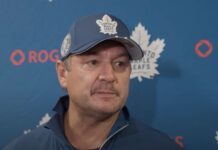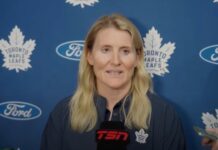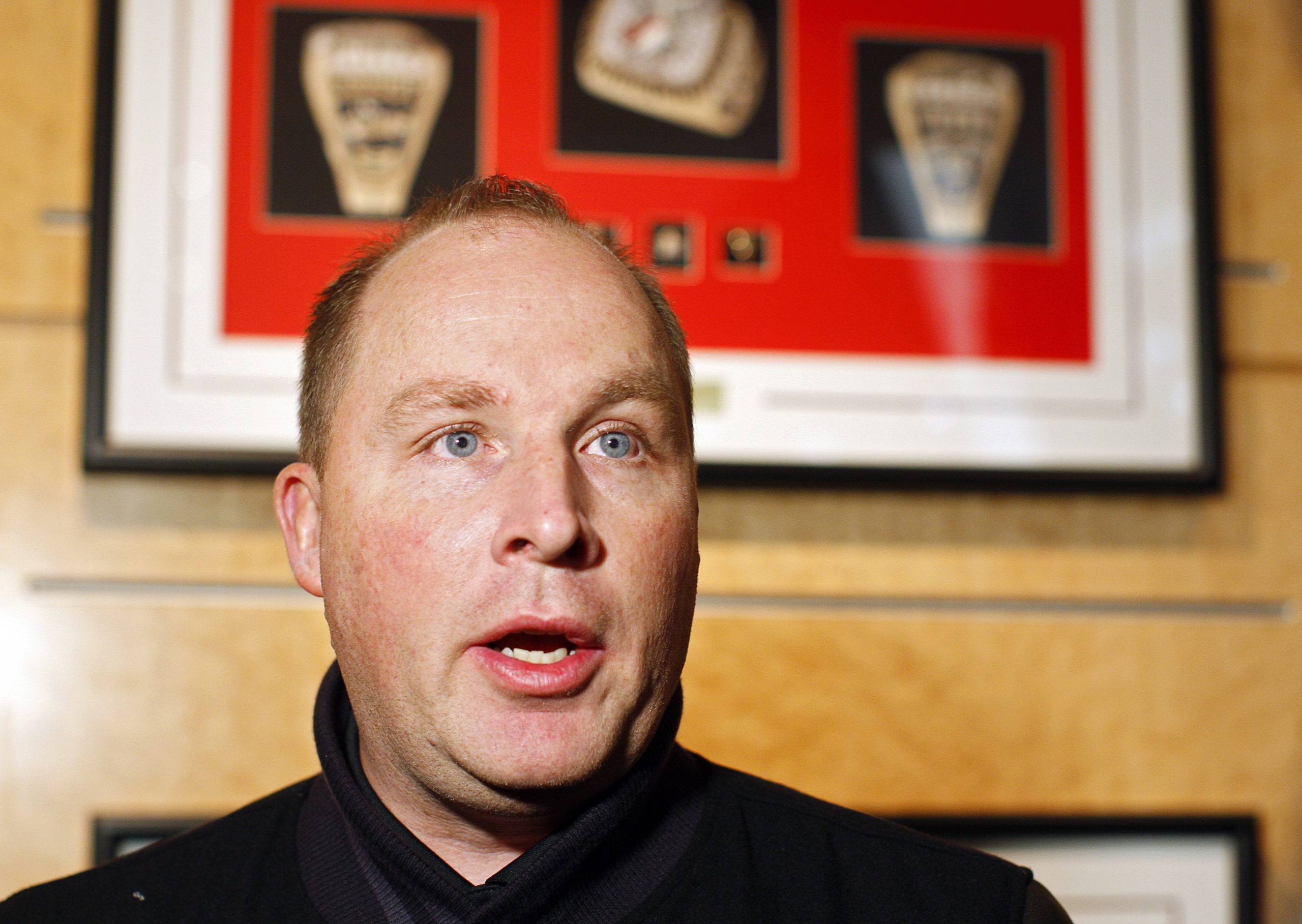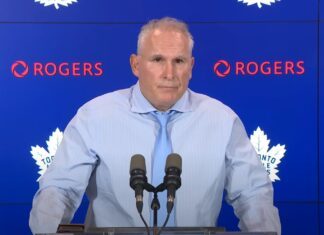MLHS’ Alec Brownscombe chatted with newly-appointed Maple Leafs assistant coach Steve Spott this afternoon. There was lots to cover ahead of the new season.
Alec Brownscombe: As a guy who grew up in a soccer family and whose father emigrated from Germany, you must be pretty pleased with last month’s World Cup result?
Steve Spott: It was awesome. I come from a traditional German background. For our family, it was pretty special watching it. Obviously, with TFC in our city, it’s great to see the sport growing here close to home.
AB: I’m a season ticket holder at TFC, actually. It’s a really good time. Do you get out to any of the games?
SS: Nope, but I’m going to. We moved to Toronto on Friday, so that’s going to give us an opportunity to take a more active role in that. My son really wants to see them.
AB: I told the guys I’d give you a hard time about this… In an interview when you were with Kitchener, you explicitly said “not Toronto” when asked about where you’d like to coach in the NHL, choosing the New York Rangers instead. What’s up with that?
SS: You know what, I like the Ranger uniform (laughs). My best friend is Adam Graves. We are almost like brothers. Having the opportunity to watch him in Madison Square Garden, winning the Cup, was just awesome. I’ve always liked New York City. Like Toronto, it’s pretty vibrant, and I think it’ll be special for me to go into (New York) to coach for the Leafs. I think that’s going to be a real neat experience.
AB: Kidding aside, this has to be the dream job incarnate, coaching for your favorite and hometown team growing up.
SS: The great thing about this — I’m a guy who grew up idolizing this team. Always wanted to play for them. Dreamed of playing for them one day. Now to have the opportunity to stand behind that bench is going to be a dream come true. I didn’t have a father that played in the NHL, or a brother or a cousin opening the door for me. I started coaching in the Toronto area and just grew as a coach. Hopefully I’m a good role model for young coaches out there — this can happen for them as well.
AB: Did you ever think it would just go bang-bang, in terms of jumping from the AHL to the NHL in a year’s time?
SS: No. I remember, 12 months ago when I interviewed for the job with Dave Nonis, the one thing he asked me was, “are you in a rush?” I said, “absolutely not.” I planned on staying with the Marlies for an extended period of time to hone my craft and to become more familiar with the professional game. It goes to show you how this industry can change real quick. Did I expect this? No, but it was a pleasant surprise.
AB: I’d like to ask about the man replacing you with the Marlies, Gord Dineen. As a new coach to the AHL last season, how much did you lean on him throughout the season?
SS: He and Derek. The best advice going into professional hockey was from Dallas Eakins. Dave Nonis told me I could have the autonomy to hire my own staff, and bringing in my own people, but Dallas Eakins reached out and said, “listen, you don’t want to lose Gord and you don’t want to lose Derek.” He could not have been any more accurate. I relied on those two guys daily. There was tremendous chemistry. I’d like to think now we’re more than just associates but good friends. They were a huge part of our team success last year.
AB: Have you met with Randy and Peter yet?
SS: We had coaches meetings about three weeks ago where we had an opportunity to come together as a staff and obviously meet Pete Horachek for the first time. We are going to get together again on the 17th, 18th and 19th of August.
AB: Have you decided on roles, in terms of the special teams assignments and who is running the D pairings?
SS: Yeah. Peter will run the defence, as he did in Nashville. He will work with the penalty killers as well. Myself and Randy will are going to be working with the powerplay and I’ll be up front with Randy.
AB: Is that PP role one you’re familiar with? I don’t anticipate we’ll see too much change there with the results from last season on that unit.
SS: It’s a strength for me. Between myself and Randy, we’ll take the lead on our powerplays. And no, when you’ve got the likes of Bozak, Kessel, James van Riemsdyk, Dion, Jake, Morgan, Cody… we’ve got some nice weapons back there. We’ll look at what other teams are throwing at us, but we also know these guys have to trust their instincts.
AB: You’ve described your general role as a communication layer between Randy and the players. Is that a role that can involve walking a bit of a tight rope at times?
SS: There’s no doubt. I think you have to be careful. I’m sure this year there were situations where Gord and Derek talked to players and it didn’t make it back to my office. There has to be trust amongst us as a staff that I have to be able to create a trust between myself and the players. If there’s a situation where Randy needs to addressed, I’ll take it to Randy. If not, our players need to know that I’ve got their back and they can come to myself or Pete at any time if they need to vent or to discuss their personal situations. We’ll make sure we support them.
AB: Some of the best coaches in the game historically, the old school guys, have strayed from direct player communication or do not make friends at all with the players. Do you think this approach is less common in the modern game, and what do you find to be the appropriate coach-player relationship?
SS: I am a believer in people first, player second. That may not be the popular choice, but that’s how I go about my business. I’ve always believed that: People first, player second. Some coaches before me would probably go the other way, but that’s just not my personal philosophy. I think, now having a teenage son, I think that these young boys and young men are maybe different than we were growing up and there has to be different ways of motivating them. There has to be a good cop and there has to be a bad cop, and if I have to be the good cop this year, I can do that.
AB: Brendan Shanahan has said that he thinks a coach can have a bad year just as a player can — and that he anticipates a rebound from Carlyle because he’s a good coach. Have you ever experienced what you would consider a “bad year” in terms of your coaching performance?
SS: The challenge we have as coaches is that we hitch our wagons to 23 players every year. As those players go, we go. They had a bad stretch, a bad month. It cost them a playoff spot. Randy Carlyle is a Stanley Cup champion. He was obviously an All Star in the League as a player. I can’t wait to learn from him. I am excited about working with and for him, just to learn. There’s no doubt, though. The challenge for us as coaches is that we hitch our wagons to these players, they hitch them to us, and sometimes it works out and some years it doesn’t. You don’t become stupid over night, I can tell you that.
AB: The Leafs also recently introduced Kyle Dubas as a new assistant general manager. Have you met with Kyle yet? If so, what do you anticipate the relationship being like between he and the coaching staff?
SS: I know Kyle well through junior. We do have a relationship. But I have no clue; what role he’s going to have with the Leafs or the Marlies is something we don’t have clarity on yet.
AB: It’s interesting. You’ve worked with two players on this current Leaf team back in junior who I consider X factors for the upcoming season. Everyone has been talking about some of the new additions, but Kadri had an adjustment year playing the full 82-game grind in a 2nd line capacity. You have to figure he takes a step forward now as a young player who has gone through that experience. Clarkson had a rocky adjustment to a new city, new team, and a new role. I personally wouldn’t describe Naz’s season as poor, but these players probably have better seasons next year. Do you think your relationships with these players can aid in that happening?
SS: I hope so. I think, first and foremost, Naz is a dynamic player and a competitive person. He’s worked extremely hard off the ice this summer to continue to work on his physical strength. I’m looking forward to him taking that next step, which is him becoming an impact player in the NHL. He’s capable of becoming that.
David had a tough adjustment, he’d be the first to admit that. He’s a player that is big on having relationships, he’s big on communication. He needs feedback on a daily basis. I think I can be that resource for him so that he can reach that level we all know he can reach.
AB: I think a lot of fans are curious as to the level of synergy between the big club and AHL club when it comes to systems.
SS: The 5 on 5 systems are the same. Where we have some creativity and some flexibility is in our powerplay and our penalty kill. With the Marlies, those might have been a little different than what Randy did last year. But the 5 on 5 systems are the same, so when the players get called up they know what to expect.
AB: The system the Leafs used last season in the defensive zone was described as a swarm — as we saw in the HBO 24/7 series with Greg Cronin’s pregame speech and as Brendan Shanahan reiterated this Spring. The Leafs literally broke records with the number of shots they allowed, which is obviously something your staff will be looking to improve this season. To my amateur eye, the points were oftentimes wide open and there were some real struggles breaking the cycle on the boards. From what I can tell — looking through the game logs – the Marlies didn’t have the same issues in terms of excessive numbers of shots against during the regular season. What are the keys to executing the swarm? Where do you think it can go wrong, or did go wrong with the Leafs?
SS: We had a couple of minor adjustments we implemented into that swarm… some different rules of when we would go into it. I’m hoping those are some of the rules we can work in with the Leafs this year, where we can make some small adjustments to it. A lot of teams use it, a lot of teams go to it, but there are some minor adjustments you can make so that, as you say, you eliminate those point shots. One point shot can lead to 2 or 3 other shots. That’s something we are going to be looking to change this season.
AB: So you don’t anticipate a move away from the swarm altogether next season?
SS: We will make modifications to it.
AB: Those shot figures were plain evidence that the Leafs struggled with possession last year. What are some ways you can coach players to be better possession players?
SS: The challenge for us is that, last year, we were a team that wanted to challenge off the rush and were willing to trade chances. We are going to have to manage the puck better through the neutral zone. That’s something I’m excited to work on with our players… puck management in the offensive zone, being stronger on pucks, protecting it for longer periods of time. You look at Los Angeles, you look at a lot of the bigger teams, one of their biggest strengths is puck protection in the offensive zone. That’s something we definitely have to get better at.
AB: What do you think the keys for this team are going to be in order to generate more offensive zone time? It was a big issue for the team, they couldn’t establish an effective forecheck followed by a sustained cycle consistently enough.
SS: Yep. We have to use our speed and skill. We’ve got to make sure we are willing to get into a competitive mode when we’ve got the puck, and not be so easy to play against. That’s going to start from the first day of training camp. Our expectation is that we hold onto that puck. We do have a lot of skill players; we can score. We just have to find ways to score that’s not off the rush; it’s going to require some blue collar work. We are going to have to start emphasizing that from day one.
You have to coach to your team’s strengths. We can score. That’s what I said to our coaching staff when we talked recently: “It’s not like we can’t score.” That’s a tough position to be in when you go into training camp and are like, “gosh, how are we going to score?” The challenge for us is managing the puck properly and defending. That’s something that can be taught; we just need buy in from our players.
AB: You used the word “competitiveness” there, and Randy stressed time and again the word “compete” last season. How do you define it?
SS: It’s simple: We have to have a desire to win every night. The expectation has to be to win every night. I think, for a lot of players we brought in here, they’re going to be good additions to our locker room.
AB: With all of this analytics talk — it seems to be the summer of analytics in terms of some of the hires around the league here in Toronto, in New Jersey, in Edmonton — there’s been some discussion about zone entries. It bears out in the numbers that a controlled entry into the zone with possession if possible is — obviously — preferred to putting the puck in deep, in terms of offense (shot attempts) produced. What are your thoughts on dump ‘n chase? When is it a good play, when is it giving away possession?
SS: We refer to that as puck management. These players know the high risk areas of the ice; when they can make a play and when they can’t make a play. We don’t need numbers as coaches to figure out opportunities to score come more often from when you cross the offensive blueline with control of the puck. In saying that, when you’ve got a 2 on 4 or a 1 on 3 and there’s a line change, you’ve got to manage that puck properly. Get it in slowly behind the defencemen and battle to get it back. Dump recoveries, and chip recoveries, become the term for us. We do have to dump the puck, we do have to recover it as quickly as possible, or chip the puck and retrieve it as quickly as possible, so we can generate zone time.
AB: The Leafs will be going from having only one regular right handed D to having three, plus Dion is familiar and prefers the right side. How important is having the handedness match the side of the ice in terms of orchestrating the breakout? Do you anticipate this being one way for the team to get out of its end a little better this season?
SS: We want to play fast defensively. It’s going to be critical. We are fortunate now to have natural right and left hand shots. As gifted as these players are in the NHL, there’s still a level of comfort when playing on your strong side.
AB: The Maple Leafs sometimes ran only 11 forwards last season and often played their 4th line very little, relatively speaking. They didn’t roll 4 lines. The Marlies appeared to roll them a little more than the Leafs did. The personnel additions seem to point to a change in approach here.
SS: I think that’s more than accurate. We (the Marlies) were a four line team last year. There were maybe 4, 5 or 6 minutes tops where we would go down to three lines. But it is a development league, it’s a little bit different. The expectation to win is every night; there’s not as much emphasis on development, it’s about winning up here. In saying that, we all agree as a staff that we have to have — with our new additions this summer — four lines that can contribute. When you look at the playoff runs, when you look at what LA went through to win the Cup, you have to have four lines that can play the game.
AB: Management added quite a few established pros to the bottom half of the roster this summer. There appears to be fierce competition ahead at camp with lots of options and depth. What is the message you’d deliver to a kid like Carter Ashton, who may have to unseat someone who has established himself in this League in order to make the opening day roster?
SS: That’s the nice thing for Carter, as well as Peter Holland. With me here, there’s a level comfort between myself and these players. That’s going to help them get a leg up. Now, they’ve got to take advantage of that opportunity where they need to convince Randy and management that they deserve to be here on a day to day basis. These are good players and we believe they can help out with the depth of our hockey club.
AB: In past seasons under Carlyle, the Leafs have had a dedicated checking center (Grabovski in Carlyle’s first season, Bolland the next) who consistently takes on the tough assignments, but don’t have an obvious one at the moment. Do you think there may be more of a by-committee approach of shared responsibility?
SS: That’s something that will have to morph and take care of itself. We’ve got some ideas for line combinations we’ve got up on the whiteboard, but generally speaking, those situations will need to take care of themselves in terms of where everyone fits in. As you said, we’ve got an abundance of forwards now, so that’s going to be a real interesting subplot, to see where we end up with our 12 guys.
It’s going to be an exciting training camp and a competitive one. Our exhibition games are going to really magnify the opportunities for some of these guys to get into a job or lose a job. That’s the exciting part, I think, for our fans this year — it’s not like we know our 12 or 13 forwards and 6 or 7 defencemen, there’s going to be a legitimate competition for jobs this year, and you want that as a staff.
AB: We’ve talked about Josh Leivo, Stuart Percy, Petter Granberg, Peter Holland, Carter Ashton as being on the cusp of making that next step. Some of these kids are a little further ahead than others but, generally speaking, these are the names being discussed. Is there anyone not on the radar as much who you could picture making a decision tough on the coaching staff?
SS: I think all of the Marlie guys who were a part of that group last year are going to be given a serious look. I think Brendan Shanahan has been transparent about that; there are going to be opportunities for jobs this year. We look at the year Sam Carrick had, Greg McKegg. We’ve got a lot of good young prospects down there. The defence with Percy and Granberg and MacWilliam. These guys are all going to be given opportunities to push for minutes, if not for the start of the year, but at some point this season. It’s nice to see the development between the Marlies and the Leafs now is really starting to pay off.
AB: William Nylander is going to get a lot of press and he’s a player who doesn’t fly below the radar screen—there’s sure to be a lot of ink spilled over whether or not he makes the team. What would he need to show for the coaching staff to consider giving him some NHL regular season games?
SS: We had him at prospect camp for a full week, and we can identify the skill and the speed this young man possesses. He’s going to be an exciting player for us for a long time. The challenge for Will, as it is for all young players, is to get bigger and stronger and gain some experience. He’ll be exciting to watch during training camp to see how he does against the big boys.
Like Morgan last year, he has to be able to play regularly, be around our hockey club, train, eat properly, learn how to be a pro. Morgan was way ahead of the curve when it came to playing in junior hockey. Will has the opportunity to play in the men’s league back in Sweden, he’s drafted by Mississauga in the OHL, he can play for the Toronto Marlies — which is a wonderful option. There’s some options here and the sky is the limit for Will. I am a believer coaches and managers don’t make those decisions, players do. He’ll make that decision for us in terms of where he best fits.






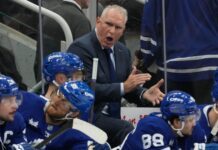
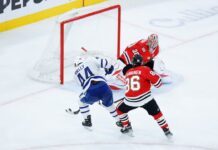


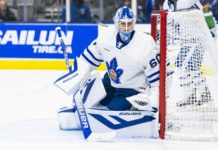


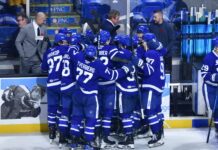

![John Gruden after the Leafs prospects’ 4-1 win over Montreal: “[Vyacheslav Peksa] looked really comfortable in the net… We wouldn’t have won without him” John Gruden, head coach of the Toronto Marlies](https://mapleleafshotstove.com/wp-content/uploads/2025/09/gruden-post-game-sep-14-218x150.jpg)

